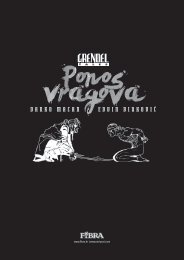Oscar Cahén
Art-Canada-Institute_Oscar-Cah%C3%A9n
Art-Canada-Institute_Oscar-Cah%C3%A9n
You also want an ePaper? Increase the reach of your titles
YUMPU automatically turns print PDFs into web optimized ePapers that Google loves.
<strong>Oscar</strong> <strong>Cahén</strong><br />
Life & Work by Jaleen Grove<br />
Establishing Himself in Canada<br />
When <strong>Oscar</strong> <strong>Cahén</strong> arrived in Canada in 1940, he was already an experienced illustrator<br />
with a recognizable style: a kind of cross between fashion illustration and caricature,<br />
drawn with a calligraphic painted line. He also used a harsh, high-contrast crayon<br />
technique for subjects that warranted an element of horror, such as a poster warning<br />
soldiers to stay away from prostitutes, and a funny, cute style for spot illustrations.<br />
<strong>Oscar</strong> <strong>Cahén</strong>, poster warning against venereal disease, c. 1944, The <strong>Cahén</strong><br />
Archives, Toronto<br />
<strong>Oscar</strong> <strong>Cahén</strong>, Praying Family, 1948, oil on canvas board, 60 x 51 cm, private<br />
collection<br />
<strong>Cahén</strong> made a major transition around 1946, when—as in Praying Family, 1948<br />
—he began painting canvases portraying people suffering, using thick paint and<br />
simplified yet exaggerated body proportions and facial expressions, in dull, depressive<br />
colours. He also painted Christian imagery using Cubist and Expressionist qualities and<br />
more intense, uplifting colours. In 1949 he made his first abstract works, characterized<br />
by unusual colour combinations and an energetic synthesis of intersecting and<br />
overlapping shapes and lines. These were executed in oils and in pastels.<br />
By 1951 he was working in bright aniline dyes on large sheets of paper or canvas,<br />
letting the dyes bleed wet into the highly wetted surface, yielding characteristic soft<br />
feathering of edges and lines. In 1951 <strong>Cahén</strong> increased his production, after receiving<br />
attention in national newspapers, in Canadian Art magazine, and in the competitive Art<br />
6<br />
Directors Annual. From that point on his works show the hot colour and cohesiveness<br />
in composition that made him so influential. By 1955 he was using an increasingly<br />
gestural line in his abstract painting, reminiscent of his illustration work, and he<br />
sometimes returned to a more sombre palette. He also began a large series of<br />
watercolours on paper using rubber cement resist and transparent layers of colour. In<br />
other works he turned again to figurative subjects.<br />
58



